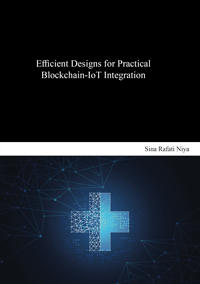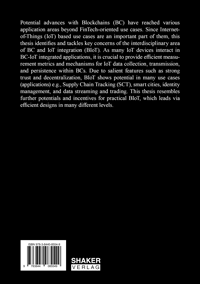
Shop : Details
Shop
Details
49,80 €ISBN 978-3-8440-8554-9Softcover234 pages67 figures347 g21 x 14,8 cmEnglishThesis
April 2022
Sina Rafati Niya
Efficient Designs for Practical Blockchain-IoT Integration
This is my Ph.D. thesis on the area of Blockchains (BC) and their integration with Internet of things (IoT) use cases. This thesis explored many specific aspects of broadly applied Blockchain-IoT Integration (BIoT) decentralized Applications (dApps) leading to the collection of deep and experimental knowledge on the BIoT ecosystem, including the impact of different protocols and technologies. As a result of the practical studies, the identification of key challenges and potentials of BIoT from an objective point of view is presented and elaborated thoroughly. It became evident that many aspects are impacting the efficiency of BIoT in practice. Driven from those BIoT dApp examples and the simulations performed, the BIoT challenges are categorized into the social, operational, performance, technical, functional, and architectural areas. Since an interdisciplinary approach contains risks, dedicated metrics were introduced for the efficiency measurement to determine the technical components that impact those. It is concluded that for an efficient BIoT, flexibility, adaptability, and manageability of the BIoT architectures must be facilitated. To reach these features, this thesis presented a BIoT architecture, i.e., BIIT, to highlight a set of management approaches, to prepare and enhance the performance of IoT networks in BIoT use cases.BIIT recommends proactively considering many aspects, including (i) Adaptive IoT technology-specific transmission scheme design, (ii) BC specific TX formatting on the IoT device side, (iii) BC client security, (iv) flexible network adaptation layer configuration on IoT device, (v) Network plugins and BC client components on Edge nodes, and (vi) on/off-chain and de-/centralized or DSSes’ integration to avoid unnecessary storage costs...
Keywords: Blockchain; Internet-of-Things; Supply Chain Tracking
Export of bibliographic data
Shaker Verlag GmbH
Am Langen Graben 15a
52353 Düren
Germany
Am Langen Graben 15a
52353 Düren
Germany
Mon. - Thurs. 8:00 a.m. to 4:00 p.m.
Fri. 8:00 a.m. to 3:00 p.m.
Fri. 8:00 a.m. to 3:00 p.m.
Contact us. We will be happy to help you.



